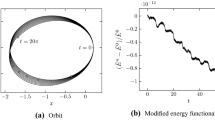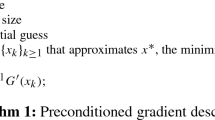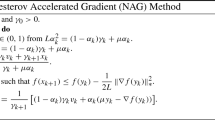Abstract
In this paper, the use of discrete gradients is considered for differential-algebraic equations (DAEs) with a conservation/dissipation law. As one of the most popular numerical methods for conservative/dissipative ordinary differential equations, the framework of the discrete gradient method has been intensively developed over recent decades. Although discrete gradients have been applied to several specific DAEs, no unified framework has yet been constructed. In this paper, the author moves toward the establishment of such a framework, and introduces concepts including an appropriate linear gradient structure for DAEs. Then, it is revealed that the simple use of discrete gradients does not imply the discrete conservation/dissipation laws. Fortunately, however, for the case of index-1 DAEs, an appropriate reformulation and a new discrete gradient enable us to successfully construct a novel scheme, which satisfies both of the discrete conservation/dissipation law and the constraint. This first attempt may provide an indispensable basis for constructing a unified framework of discrete gradient methods for DAEs.




Similar content being viewed by others
References
Ascher, U.M., Petzold, L.R.: Computer Methods for Ordinary Differential Equations and Differential-algebraic Equations. Society for Industrial and Applied Mathematics (SIAM), Philadelphia (1998). https://doi.org/10.1137/1.9781611971392
Bajić, V.B.: Lyapunov function candidates for semistate systems. Int. J. Control 46(6), 2171–2181 (1987). https://doi.org/10.1080/00207178708934041
Ben-Israel, A., Greville, T.N.E.: Generalized Inverses. CMS Books in Mathematics/Ouvrages de Mathématiques de la SMC, vol. 15, 2nd edn. Springer, New York (2003)
Betsch, P.: Energy-consistent numerical integration of mechanical systems with mixed holonomic and nonholonomic constraints. Comput. Methods Appl. Mech. Eng. 195(50–51), 7020–7035 (2006). https://doi.org/10.1016/j.cma.2005.01.027
Bloch, A.M.: Nonholonomic Mechanics and Control. Interdisciplinary Applied Mathematics, vol. 24, 2nd edn. Springer, New York (2015). https://doi.org/10.1007/978-1-4939-3017-3
Burger, M., Gerdts, M.: A survey on numerical methods for the simulation of initial value problems with sDAEs. In: Ilchmann, A., Reis, T. (eds.) Surveys in Differential-Algebraic Equations, vol. IV, pp. 221–300. Springer, Cham (2017)
Celledoni, E., Eidnes, S., Owren, B., Ringholm, T.: Dissipative numerical schemes on Riemannian manifolds with applications to gradient flows. SIAM J. Sci. Comput. 40(6), A3789–A3806 (2018). https://doi.org/10.1137/18M1190628
Celledoni, E., Eidnes, S., Owren, B., Ringholm, T.: Energy preserving methods on Riemannian manifolds. eprints. arXiv:1805.07578 (2018)
Celledoni, E., Grimm, V., McLachlan, R., McLaren, D., O’Neale, D., Owren, B., Quispel, G.: Preserving energy resp. dissipation in numerical PDEs using the “average vector field” method. J. Comput. Phys. 231, 6770–6789 (2012)
Celledoni, E., Owren, B.: Preserving first integrals with symmetric Lie group methods. Discrete Contin. Dyn. Syst. 34(3), 977–990 (2014). https://doi.org/10.3934/dcds.2014.34.977
Furihata, D.: Finite difference schemes for \(\partial u/\partial t=(\partial /\partial x)^\alpha \delta G/\delta u\) that inherit energy conservation or dissipation property. J. Comput. Phys. 156(1), 181–205 (1999). https://doi.org/10.1006/jcph.1999.6377
Furihata, D., Matsuo, T.: Discrete Variational Derivative Method—A Structure-Preserving Numerical Method for Partial Differential Equations. CRC Press, Boca Raton (2011)
Furihata, D., Mori, M.: General derivation of finite difference schemes by means of a discrete variation. Trans. Jpn. Soc. Ind. Appl. 8(3), 317–340 (1998) (in Japanese)
Furihata, D., Sato, S., Matsuo, T.: A novel discrete variational derivative method using “average-difference methods”. JSIAM Lett. 8, 81–84 (2016). 10.14495/jsiaml.8.81
Gonzalez, O.: Time integration and discrete Hamiltonian systems. J. Nonlinear Sci. 6, 449–467 (1996)
Gonzalez, O.: Mechanical systems subject to holonomic constraints: differential-algebraic formulations and conservative integration. Phys. D 132(1–2), 165–174 (1999). https://doi.org/10.1016/S0167-2789(99)00054-8
Hairer, E., Lubich, C., Wanner, G.: Geometric Numerical Integration, Structure-Preserving Algorithms for Ordinary Differential Equations, Springer Series in Computational Mathematics, vol. 31. Springer, Heidelberg (2010)
Ishikawa, A., Yaguchi, T.: Application of the variational principle to deriving energy-preserving schemes for the Hamilton equation. JSIAM Lett. 8, 53–56 (2016). https://doi.org/10.14495/jsiaml.8.53
Itoh, T., Abe, K.: Hamiltonian-conserving discrete canonical equations based on variational difference quotients. J. Comput. Phys. 76(1), 85–102 (1988). https://doi.org/10.1016/0021-9991(88)90132-5
Kojima, H.: Invariants preserving schemes based on explicit Runge–Kutta methods. BIT 56(4), 1317–1337 (2016). https://doi.org/10.1007/s10543-016-0608-y
Li, M., Yin, Z.: Blow-up phenomena and travelling wave solutions to the periodic integrable dispersive Hunter–Saxton equation. Discrete Contin. Dyn. Syst. 37(12), 6471–6485 (2017). https://doi.org/10.3934/dcds.2017280
Liberzon, D., Trenn, S.: Switched nonlinear differential algebraic equations: solution theory, Lyapunov functions, and stability. Autom. J. IFAC 48(5), 954–963 (2012). https://doi.org/10.1016/j.automatica.2012.02.041
McLachlan, R.I., Quispel, G.R.W., Robidoux, N.: Geometric integration using discrete gradients. Philos. Trans. R. Soc. Lond. A Math. Phys. Eng. Sci. 357, 1021–1045 (1999)
Miyatake, Y., Cohen, D., Furihata, D., Matsuo, T.: Geometric numerical integrators for Hunter–Saxton-like equations. Jpn. J. Ind. Appl. Math. 34(2), 441–472 (2017). https://doi.org/10.1007/s13160-017-0252-1
Miyatake, Y., Yaguchi, T., Matsuo, T.: Numerical integration of the Ostrovsky equation based on its geometric structures. J. Comput. Phys. 231(14), 4542–4559 (2012). https://doi.org/10.1016/j.jcp.2012.02.027
Olver, P.J.: Equivalence, Invariants, and Symmetry. Cambridge University Press, Cambridge (1995). https://doi.org/10.1017/CBO9780511609565
Quispel, G.R.W., Capel, H.W.: Solving ODE’s numerically while preserving a first integral. Phys. Lett. A 218, 223–228 (1996)
Quispel, G.R.W., McLaren, D.I.: A new class of energy-preserving numerical integration methods. J. Phys. A. Math. Theor. 41, 045,206 (2008)
Quispel, G.R.W., Turner, G.S.: Discrete gradient methods for solving ODE’s numerically while preserving a first integral. J. Phys. A 29, L341–349 (1996)
Reich, S.: On a geometrical interpretation of differential-algebraic equations. Circuits Syst. Signal Process. 9(4), 367–382 (1990). https://doi.org/10.1007/BF01189332
Robinson, J.C.: Infinite-Dimensional Dynamical Systems. Cambridge University Press, Cambridge (2001)
Sato, S.: Stability and convergence of a conservative finite difference scheme for the modified Hunter-Saxton equation. BIT 59(1), 213–241 (2019). https://doi.org/10.1007/s10543-018-0726-9
Sato, S., Matsuo, T.: On spatial discretization of evolutionary differential equations on the periodic domain with a mixed derivative. J. Comput. Appl. Math. 358, 221–240 (2019)
Sato, S., Matsuo, T., Suzuki, H., Furihata, D.: A Lyapunov-type theorem for dissipative numerical integrators with adaptive time-stepping. SIAM J. Numer. Anal. 53(6), 2505–2518 (2015). https://doi.org/10.1137/140996719
Uhlar, S., Betsch, P.: On the derivation of energy consistent time stepping schemes for friction afflicted multibody systems. Comput. Struct. 88(11), 737–754 (2010). https://doi.org/10.1016/j.compstruc.2010.03.003
Wan, A.T.S., Bihlo, A., Nave, J.C.: The multiplier method to construct conservative finite difference schemes for ordinary and partial differential equations. SIAM J. Numer. Anal. 54(1), 86–119 (2016). https://doi.org/10.1137/140997944
Wan, A.T.S., Bihlo, A., Nave, J.C.: Conservative methods for dynamical systems. SIAM J. Numer. Anal. 55(5), 2255–2285 (2017). https://doi.org/10.1137/16M110719X
Wan, A.T.S., Nave, J.C.: On the arbitrarily long-term stability of conservative methods. eprints. arXiv:1607.06160 (2016)
Acknowledgements
The author is grateful to Kensuke Aishima and Takayasu Matsuo for valuable comments. The author thanks the anonymous reviewers for many helpful comments.
Author information
Authors and Affiliations
Corresponding author
Additional information
Communicated by Antonella Zanna Munthe-Kaas.
Publisher's Note
Springer Nature remains neutral with regard to jurisdictional claims in published maps and institutional affiliations.
The author is supported by the Research Fellowship of the Japan Society for the Promotion of Science for Young Scientists.
Appendices
Appendix A: Continuity of \( {\overline{\nabla }}_{\mathrm {P}}V \)
-
(i)
V is quadratic, i.e., \( V(z) = (1/2) z^{\top } B z \) for a symmetric matrix B:
in this case, since \( {\overline{\nabla }}_{\mathrm {P}}V(z,z') = B (z+z')/2 \) holds, it is clearly continuous map. Note that, in this case, \( {\overline{\nabla }}_{\mathrm {P}}V = {\overline{\nabla }}_{\mathrm {AVF}} V\).
-
(ii)
V is strictly convex:
in this case, the inequality
$$\begin{aligned} 0< V(z) - V(z') - \langle \nabla V(z') , z - z' \rangle < \left\langle \nabla V(z) - \nabla V(z'), z - z' \right\rangle \end{aligned}$$holds for any \( z \ne z' \). It implies that \( \theta (z,z') \in (0,1) \) holds for \( z \ne z'\). As \( {\overline{\nabla }}_{\mathrm {P}}V \) can also be written in the form
$$\begin{aligned} {\overline{\nabla }}_{\mathrm {P}}V(z,z') = \nabla V(z') + \theta (z,z') \left( \nabla V(z) - \nabla V(z') \right) , \end{aligned}$$(A.1)the boundedness of \( \theta \) proves the continuity of \( {\overline{\nabla }}_{\mathrm {P}}V\).
-
(iii)
V is convex and \(L_V\)-smooth:
in this case, we also use (A.1), but we prove that \( \theta (z,z') \) is bounded when \( \nabla V(z) \ne \nabla V(z') \). Since V is a convex function, we see
$$\begin{aligned} 0 \le V(z) - V(z') - \langle \nabla V(z') , z - z' \rangle \le \left\langle \nabla V(z) - \nabla V(z'), z - z' \right\rangle . \end{aligned}$$This implies that \( \theta (z,z') \in [0,1] \) holds when the denominator of \( \theta (z,z') \) does not vanish. Moreover, \(L_V\)-smoothness provides us with the inequality
$$\begin{aligned} \left\langle \nabla V(z) - \nabla V(z'), z - z' \right\rangle \ge \frac{1}{L_V} \left\| \nabla V(z) - \nabla V(z') \right\| ^2 \end{aligned}$$(note that the conjugate function \( V^{*} \) is \( 1 / L_V\)-strong convex). Summing up, we see that \( \theta \in [0,1] \) holds when \( \nabla V(z) \ne \nabla V(z') \).
Appendix B: Non-convex case: sine-Gordon equation
Here we consider the sine-Gordon equation \( u_{tx} = \sin u \) which has the conservation law \( {\mathscr {H}} (u) = - \int _{{\mathbb {S}}} \cos u \, {\mathrm {d}}x = \text {const.} \) and the implicit constraint \( {\mathscr {F}} (u) = \int _{{\mathbb {S}}} \sin u \, {\mathrm {d}}x = 0 \). The spatial discretization \( D {\dot{u}} = M \sin u \) satisfies the discrete counterparts \( H(u) = - \sum _{k=1}^K \cos u_k \) and \( F(u) = \sum _{k=1}^K \sin u_k \) of the conservation law and the implicit constraint.
However, since H is not convex (and not quadratic), we do not know whether \( {\overline{\nabla }}_{\mathrm {P}}H \) is continuous. Therefore, we use a trick to construct a discrete gradient which is compatible with properness, i.e., belongs to \( {\mathrm {car}}(D) \). Let us consider the expression \( H(u) = H_1 (u) + H_2 (u) \), where \( H_1 (u) = H(u) + (\alpha / 2) \langle u , P u \rangle \) and \( H_2 (u) = - (\alpha / 2) \langle u , P u \rangle \) (\( \alpha \in {\mathbb {R}}\) is a constant and P is the orthogonal projector on the set of zero-mean vectors). In the expression, (a) \( H_1\) and \(H_2\) are proper, and (b) \( H_2 \) is quadratic so that \( {\overline{\nabla }}_{\mathrm {P}}H_2 \) is continuous. Thus, roughly speaking, it is sufficient to choose the constant \( \alpha \) such that \(H_1\) is convex. This itself cannot be done since P is a singular matrix, but a sufficiently large \( \alpha \) provides us with the similar result as shown in Lemma B.1. To this end, we assume \( H_0 := H(u_0) < 0 \) (the case \( H_0 > 0 \) can be treated similarly).
Lemma B.1
Let \( H_0 < 0 \) be a constant. Then, if \( \alpha > 1 - K / H_0 \), the Hessian \( \nabla ^2 H_1 (u ) = \mathrm {diag} ( \cos u_k ) + \alpha P \) of \( {\widetilde{H}} \) is positive definite on the domain \( \{ u \in {\mathbb {R}}^K \mid H(u) = H_0 \} \).
Proof
It is sufficient to prove \( \langle {\widetilde{v}} , \nabla ^2 H_1 (u) {\widetilde{v}} \rangle > 0 \) holds for any \( {\widetilde{v}} \in \{ w \mid \Vert w \Vert = 1 \} = \{ v \pm \sqrt{ (1-x^2)/K } {\mathbf {1}} \mid v \in {\mathbb {R}}^K , \ \Vert v \Vert = x, \, \langle v,\ {\mathbf {1}} \rangle = 0, x \in [0,1] \} \). Since
holds due to the inequality of arithmetic and geometric means, we see
Thus, for \( x \in (0,1] \), \( \langle {\widetilde{v}} , \nabla ^2 H_1 (u) {\widetilde{v}} \rangle > 0\) holds under the assumptions of this lemma. On the other hand, for the case \( x = 0\), i.e., \( {\widetilde{v}} = \sqrt{1/K} {\mathbf {1}} \), \( \langle {\widetilde{v}} , \nabla ^2 H_1 (u) {\widetilde{v}} \rangle = - H_0/K > 0 \) holds. \(\square \)
By using \( H_1 \) and \(H_2\), we can construct
which can be used like as a discrete gradient (see Proposition B.1).
Proposition B.1
Suppose that \( \alpha > 1 - K / H_0 \). The function \( {\widetilde{\nabla }} H :{\mathbb {R}}^K \times {\mathbb {R}}^K \rightarrow {\mathbb {R}}^K \) defined by (B.1) satisfies
\( H(u) - H(u') = \langle {\widetilde{\nabla }} H (u,u'), u - u' \rangle \),
\( {\widetilde{\nabla }} H(u,u) = \nabla H(u) \),
\( {\widetilde{\nabla }} H(u,u+\epsilon ) \) is continuous in the neighborhood of \( \epsilon = 0\) as a function of \(\epsilon \) for each \( u \in \{ u \in {\mathbb {R}}^K \mid H(u) = H_0 \} \).
Proof
The first two conditions are immediate. The third condition also holds since the denominator of \( \theta \) with respect to \(H_1\) is positive in the neighborhood due to the positive definiteness of the Hessian. \(\square \)
Since we do not know the continuity of \( {\widetilde{\nabla }} H \) on the whole domain \( {\mathbb {R}}^K \), it cannot be referred to as a discrete gradient (recall Definition 1.1). Fortunately, however, we can construct a consistent numerical scheme by using \( {\widetilde{\nabla }} H \), because the continuity of the discrete gradient is just a sufficient condition for the consistency of the resulting numerical scheme. In fact, the scheme (6.3) using \( {\widetilde{\nabla }} H \) defined by (B.1) was found to be solvable by “fsolve” of MATLAB R2016b. Since the behavior is quite similar to the case of sinh-Gordon equation, we omit the numerical results.
Rights and permissions
About this article
Cite this article
Sato, S. Linear gradient structures and discrete gradient methods for conservative/dissipative differential-algebraic equations. Bit Numer Math 59, 1063–1091 (2019). https://doi.org/10.1007/s10543-019-00759-2
Received:
Accepted:
Published:
Issue Date:
DOI: https://doi.org/10.1007/s10543-019-00759-2
Keywords
- Discrete gradient method
- Differential-algebraic equations
- Linear gradient form
- Conservation law
- Dissipation law




